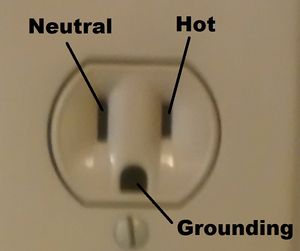Hot line: Difference between revisions
m (1 revision imported: Doing upload, largely of old redirects.) |
energy>Jmdonev No edit summary |
||
| Line 1: | Line 1: | ||
[[Category:Done 2018- | [[Category:Done 2018-08-03]] | ||
[[File:Three-pronged outlet.jpg|thumbnail|right|Figure 1. A labelled three-pronged outlet.]] | [[File:Three-pronged outlet.jpg|thumbnail|right|Figure 1. A labelled three-pronged outlet.]] | ||
<onlyinclude>A '''hot line''' (also known as a '''phase line''') is a [[wire]] in the latter stages of the [[distribution | <onlyinclude>A '''hot line''' (also known as a '''phase line''') is a [[wire]] in the latter stages of the [[distribution grid]] (like inside your [[Connecting homes to the electrical grid|house]]) that has a non-zero average [[voltage]] relative to the Earth (also called [[ground]]), as opposed to [[neutral line]]s, which are ideally at ground potential.</onlyinclude><ref> J. Andrews, ''A+ Guide to Hardware: Managing, Maintaining and Troubleshooting'', 5th ed. Cengage Learning, 2009, pp.48-49</ref> Since hot lines carry [[electricity]] that has a high [[potential energy]], they are [[shock hazard]]s. Many electrical devices minimize this risk by taking advantage of polarized [[electrical outlet]]s (see figure 1) to ensure that the on/off [[switch]] is on the hot line, effectively limiting the length of the hot line, which minimizes the risk of shock as only a relatively small segment of the wiring (the wire before the switch, as opposed to the whole device) is considered "hot" when the circuit is open.<ref>D. Lowe. ''Alternating Current in Electronics: Hot, Neutral, and Ground Wires'' [Online]. Available:http://www.dummies.com/how-to/content/alternating-current-in-electronics-hot-neutral-and.html</ref> | ||
For a more in depth discussion, including circuit diagrams please see [http://www.allaboutcircuits.com/vol_1/chpt_3/8.html All about circuits]. | For a more in depth discussion, including circuit diagrams please see [http://www.allaboutcircuits.com/vol_1/chpt_3/8.html All about circuits]. | ||
Revision as of 21:15, 26 August 2018
A hot line (also known as a phase line) is a wire in the latter stages of the distribution grid (like inside your house) that has a non-zero average voltage relative to the Earth (also called ground), as opposed to neutral lines, which are ideally at ground potential.[1] Since hot lines carry electricity that has a high potential energy, they are shock hazards. Many electrical devices minimize this risk by taking advantage of polarized electrical outlets (see figure 1) to ensure that the on/off switch is on the hot line, effectively limiting the length of the hot line, which minimizes the risk of shock as only a relatively small segment of the wiring (the wire before the switch, as opposed to the whole device) is considered "hot" when the circuit is open.[2]
For a more in depth discussion, including circuit diagrams please see All about circuits.
For Further Reading
For further information please see the related pages below:
- Electrical transmission
- Electrical grid
- Electrical generation
- Distribution grid
- Electrical outlet
- Or explore a random page!
References
- ↑ J. Andrews, A+ Guide to Hardware: Managing, Maintaining and Troubleshooting, 5th ed. Cengage Learning, 2009, pp.48-49
- ↑ D. Lowe. Alternating Current in Electronics: Hot, Neutral, and Ground Wires [Online]. Available:http://www.dummies.com/how-to/content/alternating-current-in-electronics-hot-neutral-and.html


